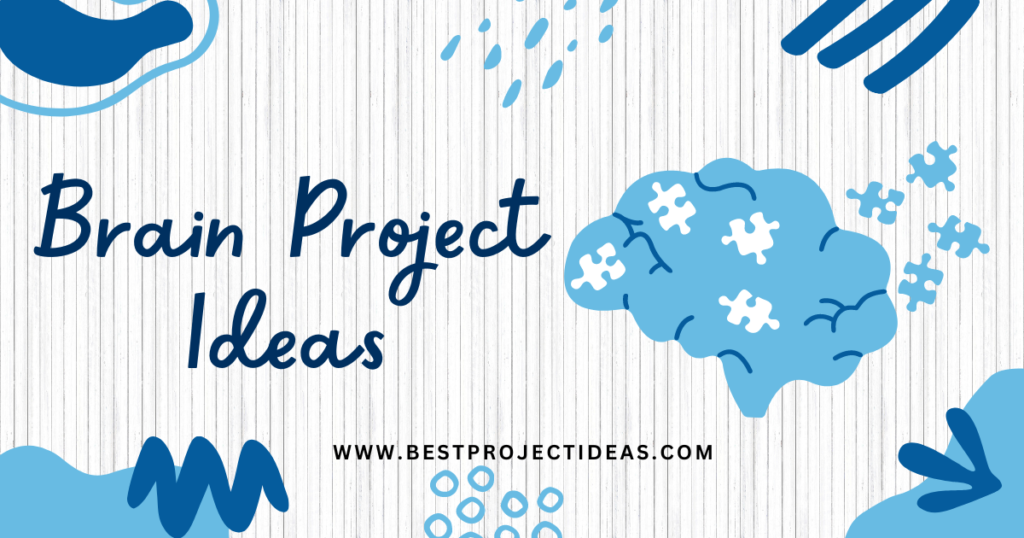
Working on brain-related projects can be a fun and educational experience for students. Understanding how the brain works helps us appreciate how we think, learn, and interact with the world.
This blog will cover why brain project ideas are important, their benefits, tips for choosing the best project, and some examples to help you get started.
Why Are Brain Project Ideas So Important for Students?
Brain project ideas are crucial for students because they spark curiosity about how the human brain functions.
These projects allow students to explore topics like memory, learning, behavior, and emotions, which are fundamental in understanding both themselves and others. Understanding the brain can also open doors to careers in neuroscience, psychology, or medicine.
Studying brain-related topics encourages critical thinking, problem-solving, and creativity. It helps students develop a scientific approach to answering questions about the human mind and body.
Must Read: 51+ Latest Diorama Project Ideas For Students (PDF Inside)
Benefits of Doing Brain Projects
- Deeper Understanding of Human Behavior: Learning about the brain helps students understand why people act or react in certain ways, boosting emotional intelligence.
- Improved Learning Techniques: By understanding how memory and learning processes work, students can apply better techniques to improve their own learning.
- Enhanced Problem-Solving Skills: Brain projects often involve experiments, which teach students how to form hypotheses, test them, and draw conclusions.
- Encourages Curiosity: Exploring the brain’s complexity fosters a lifelong interest in science and discovery.
Tips for Choosing the Best Brain Project
- Pick a Topic that Interests You: Choose a subject that you are genuinely curious about, whether it’s how memory works or what happens in the brain during sleep.
- Choose a Manageable Project: Avoid overly complicated topics. Focus on something you can complete within the available time and resources.
- Consider Real-Life Applications: Try to pick projects that have practical uses. For example, studying how the brain processes information can help develop learning strategies.
- Use Visuals and Experiments: Brain projects often benefit from diagrams, models, or hands-on experiments to demonstrate the concepts visually.
Top 20 Brain Project Ideas for Students In 2024
Here are 20 engaging brain project ideas for students. Each project includes a brief introduction followed by key features in bullet points to give you a clear understanding of the project’s purpose and execution.
1. How Memory Retention Varies with Age
This project explores how memory retention changes across different age groups. By testing short-term memory in children, teenagers, adults, and the elderly, students can learn how age affects our ability to remember information. It’s a great way to understand the workings of memory and how it evolves over time.
Key Features:
- Conduct memory tests with age-diverse participants
- Use simple visual or verbal memory challenges
- Compare and analyze results across age groups
2. Effects of Sleep Deprivation on Brain Function
This project investigates how a lack of sleep impacts cognitive abilities such as concentration, memory, and reaction time. By conducting tests on participants who have had varying amounts of sleep, students will understand the vital role sleep plays in brain function.
Key Features:
- Measure concentration and memory after different sleep durations
- Use simple puzzles or reaction time tests
- Compare results of well-rested vs. sleep-deprived participants
3. How Exercise Affects Brain Performance
Physical exercise is known to benefit both the body and the brain. This project explores how regular physical activity impacts cognitive functions such as memory, focus, and problem-solving skills, highlighting the connection between body movement and brain health.
Key Features:
- Track participants’ cognitive performance before and after exercise
- Use exercises like running or aerobics
- Analyze improvement in focus and memory post-exercise
4. Impact of Music on Learning
This project looks into how different types of music influence the brain’s ability to learn and retain information. You can compare how various genres, like classical or pop music, impact a student’s concentration and performance in tasks like reading or problem-solving.
Key Features:
- Play different music genres while participants study
- Use a control group (no music)
- Test comprehension and memory retention
5. Brain’s Response to Visual vs. Auditory Information
Do we remember what we see or hear better? This project examines the brain’s ability to process and retain visual versus auditory information by testing participants with tasks like recalling images or words after brief exposure.
Key Features:
- Use flashcards for visual memory tests
- Use recorded messages for auditory memory tests
- Analyze which type of information is retained longer
6. The Brain’s Reaction to Fear
Fear can trigger immediate reactions in the brain and body. This project involves studying how the brain processes fear, what triggers it, and how it affects decision-making and physical reactions like heart rate or adrenaline release.
Key Features:
- Discuss the science behind fear (fight or flight response)
- Use harmless fear-inducing stimuli like suspenseful movies
- Measure physiological responses like pulse rate or skin temperature
7. Impact of Caffeine on Brain Function
Caffeine is widely consumed for boosting alertness. This project studies how caffeine affects brain function, particularly focus, memory, and problem-solving skills. It’s a practical experiment for understanding the stimulatory effects of caffeine on cognitive performance.
Key Features:
- Test cognitive abilities before and after caffeine consumption
- Use puzzles or memory games
- Compare results to participants who didn’t consume caffeine
8. How Stress Impacts Short-Term Memory
Stress can negatively affect memory and concentration. This project explores how different stress levels impact short-term memory retention by exposing participants to stressful situations before testing their recall ability.
Key Features:
- Create mildly stressful tasks (e.g., timed tests)
- Measure memory performance post-stress exposure
- Discuss the role of cortisol in memory impairment
9. Exploring Left vs. Right Brain Dominance
This project investigates whether people tend to use the left or right hemisphere of their brain more and how it affects their skills and preferences, like logic (left brain) vs. creativity (right brain). It’s a fascinating way to understand brain lateralization.
Key Features:
- Use questionnaires to determine left or right dominance
- Test participants with tasks involving logic and creativity
- Analyze how brain dominance affects performance
10. How Colors Influence Brain Activity
Different colors can evoke various emotional and cognitive responses. This project examines how exposure to different colors affects the brain’s mood, attention, and focus levels during tasks like solving puzzles or memory games.
Key Features:
- Test participants’ performance under different colored lights or backgrounds
- Monitor mood changes after exposure to colors like blue (calming) or red (stimulating)
- Analyze color’s effect on cognitive tasks
11. Understanding the Brain’s Reward System
This project looks into the brain’s reward system and how it motivates behavior. By analyzing how rewards (like praise or points) affect task performance, students can understand the connection between motivation, dopamine release, and learning.
Key Features:
- Test participants with tasks offering rewards
- Compare performance with and without rewards
- Discuss the brain’s release of dopamine and its effect on motivation
12. Exploring Brain Plasticity
Brain plasticity refers to the brain’s ability to change and adapt over time. This project focuses on how learning new skills, like playing an instrument or solving puzzles, can reshape neural connections in the brain, promoting cognitive flexibility.
Key Features:
- Test participants before and after learning a new skill
- Use brain games or physical skills (like juggling)
- Discuss changes in cognitive abilities after practice
13. The Brain’s Reaction to Meditation
Meditation is known to have calming effects on the brain. This project explores how regular meditation impacts brain functions such as attention, memory, and emotional regulation, providing insights into the brain’s ability to relax and focus.
Key Features:
- Test cognitive performance before and after meditation
- Use simple breathing or mindfulness exercises
- Discuss the effects on mood, focus, and stress levels
14. How Emotions Affect Decision-Making
Emotions play a significant role in how we make decisions. This project examines how emotional states like happiness, anger, or sadness can influence decision-making processes in tasks involving choices, risks, or moral judgments.
Key Features:
- Expose participants to emotional stimuli (happy or sad videos)
- Test decision-making with various scenarios or dilemmas
- Analyze the impact of emotions on choices
15. How Multitasking Affects the Brain
Multitasking is often thought to be efficient, but it can strain the brain. This project tests how trying to perform multiple tasks simultaneously affects focus, memory, and task completion time, helping students understand the limits of brain capacity.
Key Features:
- Create tasks requiring simultaneous attention (e.g., reading while solving math problems)
- Measure performance accuracy and time
- Compare single-tasking vs. multitasking results
16. How Sugar Affects Brain Function
Sugar consumption is linked to energy boosts, but too much can negatively affect brain function. This project investigates how sugar intake impacts cognitive abilities such as focus and memory, using simple problem-solving tests.
Key Features:
- Test participants before and after consuming sugary snacks
- Use puzzles or memory challenges to measure performance
- Compare results with a control group
17. Effect of Video Games on Brain Performance
Video games can impact brain function in both positive and negative ways. This project examines how playing different types of video games (like puzzle vs. action games) affects cognitive abilities like problem-solving and hand-eye coordination.
Key Features:
- Test participants’ performance in brain games before and after gaming
- Compare effects of different game genres
- Discuss positive and negative impacts on cognitive skills
18. The Brain and Language Learning
Learning a new language is a great way to strengthen the brain. This project focuses on how the brain processes new languages and how it can improve cognitive flexibility, memory, and problem-solving skills through language learning.
Key Features:
- Test participants’ memory and attention before and after learning basic foreign phrases
- Discuss the brain’s capacity for language learning
- Analyze improvements in cognitive abilities
19. The Role of the Brain in Reflex Actions
Reflex actions are quick, automatic responses to stimuli. This project studies how the brain and nervous system interact to produce reflexes by testing simple tasks like catching a ruler dropped without warning.
Key Features:
- Conduct reflex tests using different stimuli (sound, light)
- Measure reaction time
- Discuss the role of the spinal cord and brain in reflexes
20. How Technology Affects Brain Health
With increased screen time, technology can have both positive and negative effects on the brain. This project investigates how using phones, tablets, or computers impacts brain function, focusing on attention span, memory, and cognitive flexibility.
Key Features:
- Track participants’ focus and memory after varying screen time
- Use technology-free vs. technology-heavy scenarios
- Analyze the effects of prolonged technology use
These project ideas offer a deep dive into various aspects of how the brain works, with experiments that allow students to explore memory, learning, emotions, and more!
Must Read: 121+ Project Proposal Title Ideas For Students (Updated)
Additional Project Ideas
- The Science of Sleep: Investigate how the brain cycles through different stages of sleep.
- Left vs. Right Brain Functions: Test if there’s a difference in how people use the left or right side of their brain for certain tasks.
- Brain Plasticity: Study how the brain changes when you learn new skills over time.
- The Role of Emotions in Decision Making: Conduct experiments to show how emotions affect the brain’s decision-making process.
Final Thoughts
Brain projects are not only educational but also exciting, as they allow students to dive into the fascinating world of neuroscience.
Choosing the right project is key—pick something you’re interested in, ensure it’s feasible, and remember to have fun with it!
Whether you’re testing how stress affects memory or creating a model of the brain, these projects will expand your understanding of how the human brain works and its importance in everyday life.

